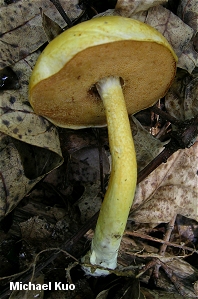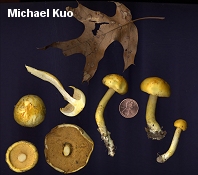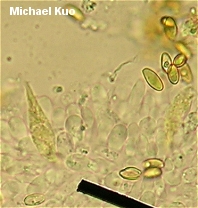| Major Groups > Boletes > Boletus > (Suillus) > Boletus curtisii |

|
Boletus curtisii [ Basidiomycetes > Boletales > Boletaceae > Boletus . . . ] by Michael Kuo The first time I found Boletus curtisii I thought it was a Suillus, since the mushroom is so slimy and so--well, Suillus-ish. True, I found it under hardwoods, but there are a very few Suillus species described from hardwood habitat, and they are yellow (or yellowish), at that. True, the pore surface is not conspicuously radially arranged (say that three times fast) and true, there are no glandular dots on the stem. In fact, of the five attributes defining Suillus I give to my readers on the page for the genus, Boletus curtisii matches only one feature: the sliminess. Maybe you won't have as much trouble as I did getting away from Suillus and into the genus Boletus, but I have included Boletus curtisii in my Suillus key, just in case. One recent DNA study (Binder & Hibbett, 2004) places Boletus curtisii in a group with Boletus ornatipes and Boletus griseus. Description: Ecology: Mycorrhizal with hardwoods or conifers; growing alone, scattered, or gregariously; summer and fall; primarily southern in distribution but recorded from New England, Michigan, and Illinois. Cap: 3-9 cm; convex, becoming broadly convex or almost flat; very slimy when fresh; bald; bright yellow or orangish yellow; staining waxed paper or paper collection bags yellow; the margin with a pale, overhanging portion. Pore Surface: Often depressed around the stem or receding from it; whitish to pale yellow when young, becoming yellowish brown; not bruising; 2-3 pores per mm; tubes 6-12 mm deep. Stem: 6-12 cm long; .5-1.5 cm thick; more or less equal; slimy; bald or with tiny fibers near the apex; yellow; basal mycelium white and prominent. Flesh: Whitish; not staining on exposure. Odor and Taste: Not distinctive. Chemical Reactions: Ammonia negative on cap and flesh; KOH negative to pale olive on cap, orangish on flesh; iron salts negative on cap, bluish gray on flesh. Spore Print: Rusty brown. Microscopic Features: Spores 9.5-17 x 4-6 µ; smooth; subfusoid. Cystidia fusoid-ventricose to more or less clavate; up to 80 x 10 µ; golden to brownish in KOH. REFERENCES: Berkeley, 1853. (Saccardo, 1888; Coker & Beers, 1943; Singer, 1947; Snell & Dick, 1970; Weber & Smith, 1985; Metzler & Metzler, 1992; Both, 1993; Bessette, Roody & Bessette, 2000; Miller & Miller, 2006; Kuo & Methven, 2010.) Herb. Kuo 07290307, 07190806. This site contains no information about the edibility or toxicity of mushrooms. |
© MushroomExpert.Com |
|
Cite this page as: Kuo, M. (2007, January). Boletus curtisii. Retrieved from the MushroomExpert.Com Web site: http://www.mushroomexpert.com/boletus_curtisii.html |


